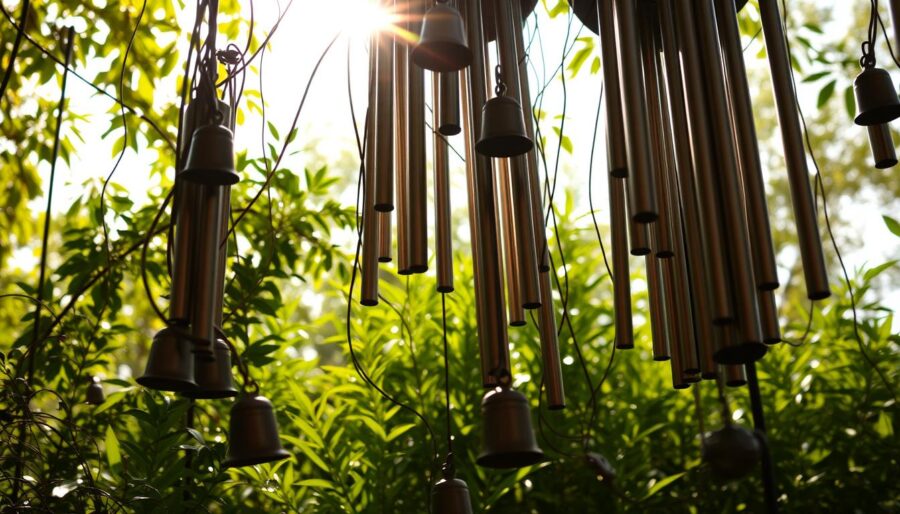You might love the thought of a breezy porch with calming sounds. But, you know wind chimes can become a noise issue during windy nights. This piece will help you enjoy the soothing noises without the worry of upsetting neighbors, breaking community rules, or disturbing babies.
This article offers clear advice based on real experiences. You’ll find out why wind chimes are soothing in gentle breezes and why they get loud when the wind picks up. You’ll learn how different materials affect sound, how placement influences loudness, and how small changes can keep your yard peaceful.
We’ll also explore rules about noise in the U.S. Some places have limits on outdoor noise, and some housing communities restrict wind chimes. You’ll get tips on being considerate, like moving your chimes to less windy areas or using softeners to dull the noise. We’ll even touch on keeping babies comfortable, so your love for chimes doesn’t disrupt sleep.
If you’re looking for a peaceful atmosphere or concerned about causing a disturbance, this guide has practical steps. The aim is to enjoy your wind chimes while maintaining harmony in your neighborhood and your home.
Understanding Wind Chimes and Their Appeal
You first see wind chimes with your eyes, then hear them with your ears. Slim metal or bamboo tubes catch sunlight, creating a beautiful sight. When the wind plays them, a soft melody fills the air. Their various lengths produce sounds like a xylophone, bringing soothing, steady music to any porch or patio.
The gentle sway of wind chimes works as white noise. It’s perfect for reading, napping, or talking outside. In a calm spot, their predictable sounds can soothe babies during their daytime naps. They also have a handy use in the garden, keeping pigeons away from plants gently.
Wind chimes make outdoor spaces look more put together, much like a throw pillow on a bench. You can choose ones that match your outdoor decor. They make a space feel special, not messy. Many find them spiritually meaningful too. They remind people of protection near doors or bring back happy memories from a gift or trip.
Hearing them chime softly at dusk brings a special feeling. It’s not just their beauty. The way they blend sound, movement, and light creates a peaceful spot for relaxing and breathing easy.
| Aspect | What You Perceive | Why It Matters | Everyday Use |
|---|---|---|---|
| Sound Character | Soft, layered notes and gentle white noise | Creates a soothing ambiance without sharp peaks | Reading on the deck; baby comfort during naps |
| Visual Presence | Clean lines, reflective metal, or warm bamboo | Enhances outdoor decor with light and motion | Completes a patio theme or garden path |
| Cultural Meaning | Traditions and spiritual significance | Adds emotional depth and personal attachment | Hanging near entries or memorial corners |
| Functional Benefit | Subtle movement and sound cues | Helps deter certain birds from planters | Protects herbs and seedlings with grace |
The Calming Benefits of Wind Chimes
You hear a light chorus at the edge of the porch, and your breath slows. The noise from well-tuned wind chimes blends into a gentle backdrop, encouraging relaxation. Soft tones can fill a quiet spot without overwhelming your thoughts, perfect for reading, stretching, or resting.
Many people use chimes as white noise for better sleep. Their steady shimmer can block out traffic sounds and distant chatter. This outdoor noise reduction is great when you have a window open on mild nights. In a covered area, the sound remains smooth and low, aiding your body to relax.
To create a peaceful garden, opt for smaller, lighter chimes with mellow sounds. Brands like Woodstock Chimes or Music of the Spheres are good choices. Their sounds mix well with plants, water features, and lights. This combination can make your patio a calm place to relax after a busy day.
For families with babies, it’s important to place chimes where the wind is gentle and the tones stay soft. A slight ringing can act as a soothing sound blanket. However, avoid placing them where loud sounds could disturb sleeping areas. Careful placement ensures the chime’s noise is calming, not startling.
Remember, strong winds can make the chimes louder and unpredictable. This can disturb your peace or that of your neighbors. Try different spots when it’s windy to see where the sound is most even. Doing so lets you enjoy the relaxing benefits without bothering anyone.
The Science Behind Wind Chimes Noise
Wind chimes sound off when a clapper hits tubes, bells, or gongs. The shape and size of these parts set a specific sound frequency. This decides the pitch, and the material affects the sound quality.
Long tubes of aluminum create deep, long-lasting tones. Brass and gongs sound strong and clear, while bamboo gives off softer notes that fade quickly. A heavier clapper makes the chime louder, even without breaking noise rules.
Wind speed controls the chime’s sounds. Strong winds keep the chimes ringing non-stop, changing as the weather does. On windy days, loud and varied sounds can spread far and wide.
Different designs can change the chimes’ sounds. The length of tubes, the weight of the clapper, and how they hang can alter the sounds. Using materials like felt can soften the chimes without losing their musical note.
Where you place the chimes affects their sound. Near walls, the sound bounces and gets louder. Setting them in less windy spots with good tuning makes them sound nice but not too loud, following city noise rules.
Common Wind Chime Materials and Their Sounds
The material you pick for your wind chimes changes how loud and what kind of sound they make. When the wind blows, you might hear bright, clear notes from metal or soft, woody knocks from wood. The size and the weight of the striker play a big role too. Larger tubes and heavier clappers make more noise, especially in windy places.
Aluminum chimes are very popular. They have a nice tune, withstand the weather, and sound like a clear bell. Steel chimes are a bit sharper and usually cost less. Copper chimes have a soft sound and get a special look over time. Brass gongs make deep, full noises that really fill the air.
Bamboo chimes make a soft, calming noise that many people like. They’re not as sharp as metal chimes. The materials used make them naturally quieter. But, if the strings wear out, the sound changes.
Bell chimes can be just bells or a mix with other materials. They don’t have a clapper inside. Instead, the wind moves the chime to make the sound. Small bell chimes sound gentle, but larger ones are louder. Putting them under an eave can help control the noise.

| Material | Typical Sound | Loudness Tendency | Durability Notes | Care Tips | Best Use |
|---|---|---|---|---|---|
| Aluminum chimes | Clear, bright, long sustain | Medium to high with larger tubes | Highly weather-resistant | Wipe tubes; check striker and strings | Tunable sets with precise pitch |
| Steel (tubular) | Bright with a slight edge | Medium; can project in strong winds | May rust if coating fails | Inspect finish; dry after storms | Budget-friendly, sturdy options |
| Copper (tubular) | Warm, rounded tone | Medium; smoother presence | Forms a natural patina | Seal if you prefer a shiny look | Decorative, mellow soundscapes |
| Brass gong | Deep, resonant, lingering | High in open wind | Durable; needs periodic polish | Position away from direct gusts | Statement resonance and presence |
| Bamboo chimes | Soft, hollow, calming knock | Low to medium; less piercing | Can crack or rot without care | Oil seasonally; keep ends dry | Cozy porches and shaded niches |
| Bell chimes | Ping to chime, short sustain | Varies by size and count | Metal bells are hardy; strings wear | Retie frayed cords; space bells evenly | Hybrids or compact installations |
| Glass/Sea-glass mixes | Light, tinkling shimmer | Low; carries in close range | Brittle in hail or high wind | Hang in sheltered locations | Decor-first, gentle ambiance |
If you prefer quieter sounds, choose smaller tubes or chimes with thicker walls. For a louder sound, try a brass gong or big aluminum chimes. Bamboo chimes are in between, with a warm sound that’s not too sharp. Each option offers a different mix of sound, loudness, and how it handles wind.
Personalizing Your Wind Chime Experience
You can make your wind chimes sound unique by choosing different materials, sizes, and tunes. If you think a sound is too sharp, try changing from aluminum to brass, or pick bamboo for a gentle tap. Smaller chimes produce less noise, while bells or gongs have clear tones that are not too loud.
Where you put your chimes can change how they sound. Hanging them in a corner of your porch, where it’s not too windy, makes their sound softer. If you want less noise at night, you can tie the striker with a string or rubber band. Wrapping the striker in fabric or bubble wrap, or putting cotton inside the tubes, also reduces noise without altering their appearance.
Think about the people living close to you. For a baby’s peaceful sleep, pick chimes with gentle, consistent sounds and place them far from sleeping areas. Suggest quiet, custom chimes or move your chimes to a spot far from others, so you can enjoy them without bothering neighbors.
Your outdoor decoration can inspire your chimes’ design. Themes like the ocean, forest, or sky can be matched with wind chimes of sea glass, driftwood, or star and sun designs. Choose a design that goes well with your yard or porch. Then, adjust the sound of your chimes so they enhance your outdoor area.
- Choose smaller, personalized chimes for a soft background noise; save bigger ones for spacious areas.
- Hang chimes in protected areas away from your neighbors to manage volume.
- Cover bamboo touching points with felt or bubble wrap to muffle sounds; use light ties on strikers for silent evenings.
- Try different tunings until the chime harmonizes with your surroundings and daily life.
The Debate Over Wind Chimes Noise
You hear a soothing tone; your neighbor hears never-ending outdoor noise. This difference sparks debates about wind chimes. At night, their clanging reaches through bedroom windows. What’s more, gusts can turn their mild sounds into non-stop noise. Everyone has their own taste in sound, and the chimes’ design can affect opinions.
Retailers like TN Nursery see divided views. Owner Tammy Sons reports mixed reactions. Some customers find the sounds beautiful, but others struggle to talk over them. Since you can’t turn the chimes off, their unexpected noise can interrupt both relaxation and sleep.
Communities often debate whether to prioritize neighborly peace or personal pleasure. On some streets, chimes add to the environment; on others, they’re seen as disruptive. Factors like wind, how close houses are, and storm frequency play a big role. While some attach sentimental value to their chimes, loudness and how often they sound can upset neighbors.
When wind turns your chimes loud, it becomes a matter of balancing your enjoyment with neighbors’ comfort. Solutions come from respectful talks and understanding what the community likes. It’s about keeping up with what everyone finds acceptable.
Strategies for Managing Wind Chime Noise
To cut down on wind chime noise, start with easy fixes. Place them where strong winds are less but gentle breezes can still flow. Put the chimes closer to your house or under shelter, and keep them away from neighbors to better manage sound outdoors.
To lessen noise right at the source, use simple ties. When silence is needed, secure the clapper with string or a rubber band. Wrap the striker with fabric or bubble wrap to mute sounds softly. For bamboo chimes, stick thin felt or bubble wrap inside to soften clanks but keep their look the same.
To make metal tubes quieter, use cotton batting inside. By inserting tiny amounts into the ends, you’ll reduce noise but keep them looking neat. For bells, cushioning their hitting points can lower harsh sounds.
Opt for smaller, less noisy chimes when buying new ones. Take them inside during strong winds. If a neighbor’s chimes are loud, focus on keeping your own home quiet. Use double-pane windows and tight weatherstripping to block noise. Heavy curtains from NICETOWN can also help.
For a quiet option, switch to decorations that look good but don’t make noise. This way, you keep the beauty of chimes without the sound, making shared areas more peaceful.
Legal Considerations for Wind Chimes
When you hang chimes, you need to think about two things: noise laws and HOA rules. First, look into your city’s rules about outdoor sounds. These often get stricter at night, from 10 p.m. to 7 a.m. Daytime noise might be okay, but nighttime quiet is expected. Make sure to read your city’s specific rules and HOA guidelines before setting up your chimes.
In Fort Worth, the noise limit is often 70 dB at your boundary line. Many small chimes are quieter than this. But, cities might still find them too noisy if they bother your neighbor. A sound, like chimes reaching into someone’s home, can be considered a nuisance even if not measured.
Some neighborhoods have extra rules. For example, HOA guidelines might say where chimes can go or not allow them at all. They might ask you to move your chimes, shorten them, or pick quieter ones. Checking with your HOA first can save you from getting a warning.
If problems come up, talking it out calmly is a good first step. Remember to note when and how long the chimes sound. If the issue doesn’t get better, you might need to take further steps. These can include mediation, a call to code compliance, or making a formal noise complaint. Remember, it’s rare for these issues to end up in court. But, constant noise or chimes close to someone else’s property can get extra attention.
To avoid problems, pick a small chime and place it carefully, like under an eave or among bushes. This way, you respect the noise rules and stay on good terms with your neighbors. Using a timer, a removable hook for nighttime, and watching the wind will help you meet the community’s standards.

Wind Chime Care and Maintenance
Keeping your wind chimes in good shape makes the sound better and your neighbors happy. First, think about where to hang it. Choose a spot with steady breezes but not too strong, to keep it safe and sound nice outside. It’s smart to bring them inside when it storms or gets very windy to avoid damage or loud sounds at night.
Know that different materials age uniquely. Consider aluminum compared to steel based on your area’s weather and what you can spend. Aluminum is great for fighting rust and staying in tune. Steel is more budget-friendly and can be recycled, but lower quality ones might rust. Copper gets a nice green patina, and brass is often used for bells and gongs because it shines.
Wood parts like the hub and sail need regular care. First, clean them. Then, protect with clear oil or varnish to stop rot and algae growth. Don’t forget to treat the edges and any screw holes to keep moisture out. If your chime is outside all the time, reapply the protective coat every season.
The strings face a lot of stress. Check them every month for any frays, knots, or tangles that can mess up the sound. Replace the strings regularly with ones that resist sun damage to keep the chime sounding its best. While fixing tangles might help temporarily, new strings help more with sound.
How the chime hits together, or its “voice,” is important too. Make sure the clapper and striker are lined up right so the tubes or bells hit correctly. If a bell sounds too sharp, use a little bit of felt or rubber to soften it. Pad each bell on its own to keep the music sounding nice but a bit softer.
For cleaning metal tubes, use gentle soap and water and dry them well. Stay away from rough cleaning pads that could scratch the metal and lead to rust. If you have copper and like the darker, mellow look, let it get a patina. Or if you prefer it shiny, polish it carefully without making the metal too thin.
Good habits can make your wind chime last longer, keep its color, and ensure it sounds consistent. Spending a few minutes on it each month can save the look, the strings, and the beautiful sound you love.
- Choose corrosion-resistant metals after comparing aluminum vs steel.
- Schedule wood treatment before wet or hot seasons.
- Do string replacement with UV cord to prevent fray and tangling.
- Fine-tune clapper alignment and add gentle damping where needed.
- Relocate to a sheltered spot and bring indoors during extreme wind.
Buying Wind Chimes: What to Look For
Begin your search for wind chimes by thinking about where you’ll hang them. Imagine the spot and how much wind it catches. Corners that get less wind can reduce noise from outside. If you have HOA rules, choose sizes that won’t bother neighbors and keep them away from shared fences.
Choose the material based on what sounds good to you. Aluminum chimes last long and can be tuned to perfect notes. Steel is a budget-friendly choice that sounds bright. Copper is pricier but ages beautifully and sounds warm. Bamboo chimes, which are softer and not as sharp, are often liked for small areas.
Your choice of scale is important, too. Bigger tubes and heavier strikers mean sounds that last longer and are louder. For a quieter sound on your porch, look for models that are not as loud, have shorter tubes, or have thicker walls that make the sound softer. If you don’t like the sound, try different materials or designs until it feels just right.
The style and overall vibe are key. Bamboo chimes and ones with sea‑glass or driftwood look great in coastal or bohemian themes. Aluminum chimes with specific scales can create harmonious music instead of just random noises.
Consider how you might control the sound. Have things like soft ties for the striker, felt washers, or removable mufflers ready to adjust the volume. Smaller wind chimes work best in limited spaces and are less likely to bother your neighbors when it’s windy.
| Material | Tone Profile | Loudness Tendency | Best Use | Care Notes |
|---|---|---|---|---|
| Aluminum | Clear, tunable, sustained | Medium to high with larger tubes | Precise scales, musical harmony | Rinse occasionally; check cords and striker wear |
| Steel | Bright, economical | Medium; can get sharp in strong winds | Budget buys, casual patios | Dry after storms; watch for rust on untreated parts |
| Copper | Warm, rounded; develops patina | Medium; resonance grows with size | Design focus, premium accents | Let it patinate or seal to preserve shine |
| Bamboo | Mellow, woody, less high‑pitched | Low to medium; shorter decay | Neighbor-friendly setups, smaller yards | Oil lightly; keep out of constant soaking rain |
| Brass/Gongs | Deep, resonant, ceremonial | High if large; powerful strike | Open gardens, spaces with distance | Wipe to reduce tarnish; secure stable hanging |
| Specialty Mix (Sea Glass, Driftwood) | Soft clinks, airy texture | Low; brief, gentle sounds | Balconies, porches seeking quieter models | Check knots and lines; clean salt residue |
Popular Wind Chime Styles and Designs
Wind chimes combine beauty with sound. Tubular chimes made of aluminum, steel, or copper produce clear, tunable notes. They sound like a xylophone. Brass gongs offer a deep ring, ideal for large yards and porches.
Bamboo designs have a softer sound. They make warm, earthy rhythms that don’t last long. This is good for keeping noise down near patios and bedrooms. For a beachy vibe, sea glass chimes on driftwood make light, glassy sounds. This sound is gentle and less intrusive to many.
The design affects both look and sound. Sets with a musical theme add pitch control to tubular chimes. Sets that focus on bells or mix bells with tubes create a bright sound. But, they won’t take over your space.
Think about where you’ll put them. Pick louder chimes for far spots like a reading nook. Choose quieter ones near doors or windows. Decorative chimes—with butterflies, hearts, suns, stars—enhance gardens and pergolas. Non-sounding hangers add charm without noise in crowded areas.
- Tubular chimes: Tunable, melodic notes; strong projection for open yards.
- Bamboo designs: Warm, mellow tone; good for close seating areas.
- Sea glass chimes: Soft clinks; blends with coastal or bohemian outdoor decor.
- Bell and gong sets: Bright or deep resonance; use where airflow is steady.
- Non-sounding ornaments: Visual charm without added wind chimes noise.
Conclusion: Are Wind Chimes Right for You?
Deciding if wind chimes are right for you depends on where you live, your neighbors, and how much noise you like. If you want your porch peaceful or enjoy soft background sounds, you can control their sound. You can place the chimes in a protected spot, cushion the clapper, or cover the tubes with soft cloth. Smaller chimes or bamboo ones are quieter yet still add warmth. They’re good for short, calm naps for babies.
Think about how much noise is already outside. In crowded places or where there are strict rules, pick chimes that are really quiet or choose decorations that don’t make noise. Aim the chimes towards where you sit, not towards your neighbors, and don’t hang them near bedrooms. If the wind gets too strong, you can stop them from moving with a tie or a magnet until it’s calm again. Doing these things means your chimes won’t bother your neighbors.
It’s important that your chimes last a long time without getting damaged. Look out for signs of damage like wood rot, rust, and strings that break and make the chimes louder. Taking care of them regularly keeps their sound soft and prevents loud noises at night. If there’s a problem, talk about it early on and find a solution, like using quieter materials, adding a silencer, or using smaller chimes. You can also make your house more soundproof to block out any extra noise.
Finally, pick chimes that fit your space the best. If you love a peaceful atmosphere, go for bamboo, small sizes, and putting them in sheltered spots. If you live in a busy area or there are rules about noise, choose very quiet chimes or decorations that don’t make sound. By thinking carefully about your choices, you can have relaxing sounds around without disturbing your neighbors.




